OLED (Organic Light Emitting Diodes) is a flat light emitting technology, made by placing a series of organic thin films (usually carbon based) between two conductors - and these films light up when electrical current is applied. OLEDs are used to make display and lighting panels. OLED displays an offer excellent image quality, are thinner, more efficient than LCD displays, and they can be flexible.

One of the major problems with those organic materials is that they are very sensitive to oxygen and moisture. This means that OLEDs need to be protected - as even a single water or oxygen molecule can harm the OLEDs.
Thin Film Encapsulation (TFE)
With regular (rigid) OLED panels, one can use a glass sheet. Glass is a great barrier, and it is widely used in the display industry and so easy to handle.
For flexible panel, rigid glass is not a a good option, and in such panels producers use different techniques, collectively referred to as Thin Film Encapsulation, or TFE. TFE is a multi-layer film, made from alternating organic and inorganic layers.
Most organic layer TFEs use an inkjet printing process. Inkjet printing is used to deposit the organic TFE materials. Kateeva launched an encapsulation inkjet printer system towards the end of 2014, and in 2016 the company announced that it secured the "vast majority" of available TFE orders.
The inorganic TFE material deposition can be done in different methods. The incumbent technology for the inorganic TFE deposition is Plasma-enhanced chemical vapor deposition (PECVD) while Atomic Layer Deposition (ALD), a modification of the basic CVD process, seems to be gaining ground in the TFE market as it enables thinner and more uniform films.
Further reading
The latest OLED encapsulation news:
LG Display halts flexible OLED production at its E6 line due to encapsulation equipment glitches
According to a report from Korea, LG Display has halted production at one of its production lines at its E6 production fab, LG's 6-Gen flexible OLED line that commenced production at the end of 2018.
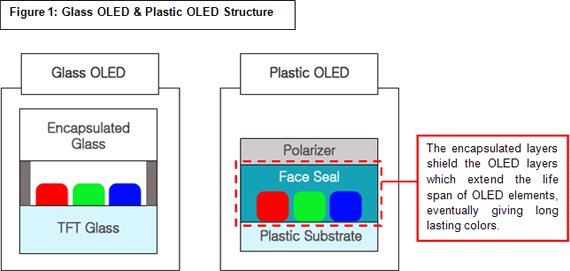
According to the report, the problem lies with LGD's thin film encapsulation equipment - specifically the equipment that deposited the organic particles - which apparently suffers from sub par performance, not good enough for commercial production. LG is using equipment made by its subsidiary LG PRI in the E6-1 line, which is now halted.
KAIST researchers develop a washable wearable solar-powered OLED device
Researchers from the Korea Advanced Institute of Science and Technology (KAIST) developed a self-powered wearable and washable OLED display device. The whole device is fabricated on textiles and the efficient OLED devices are driven by polymer solar modules.
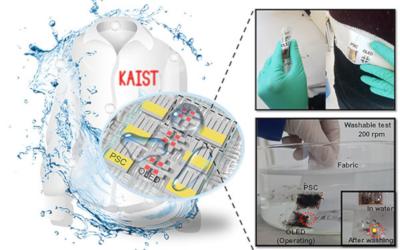
Both the OLED device and the polymer solar panels are sensitive to moisture and oxygen, and regular OLED encapsulation will not protect such a device when washed. The researches designed a new washable encapsulation barrier using both ALD and spin coating. The device is flexible (curvature radius of 3 mm) and survived 20 washing cycles of 10 minutes each with little change in performance.
Digitimes details Samsung's QD-OLED TV production plans and equipment
Samsung Display is developing hybrid QD-OLED TV technology, and according to estimates, the company aims to begin trial production in 2019. It is also estimated that Samsung has several challenges to overcome, but according to new reports from Digitimes, Samsung is aiming to start installing equipment for the new fab as early as December 2018.
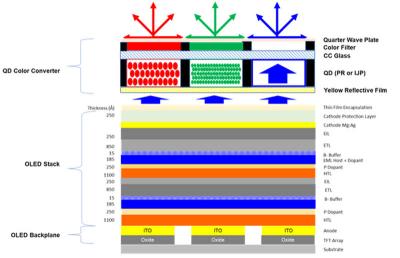
The new fab will begin operation in the second half of 2019 - pilot production at first which will be expanded to full scale mass production. The new fab will be built in Samsung's L8 LCD production line in Asan, and will take over one of the two lines currently in operation at the fab. Samsung's initial production capacity will be around 25,000 monthly G8 substrates.
The EU-funded Flexolighting project believes that OLED lighting cost can be reduced to 1 Euro per 100 lumens
In 2015, the EU launched the â¬4.4 million Flexolighting project (led by Brunel University London) with an aim to develop new materials, processes and methods to overcome current OLED lighting challenges - including lifetime, lighting uniformity and more.
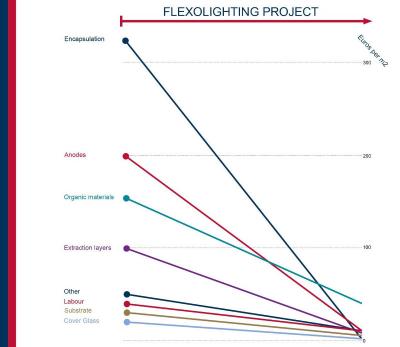
The project's consortium announced that following the project completion and a rethinking of the complete OLED supply chain, it believes that high efficiency OLED lighting panels can be produced at a cost that is on a similar level with LED lighting.
Meidensha developed a new process to cost-effectively produce bendable barrier films
Japan-based Meidensha Corporation announced that it has developed a new technology to deposit barrier films for bendable displays and electronics. The new process is done at very low temperatures (30 C) which can significantly lower energy costs compared to current plamsa-based processes (usually run at 100-150 C).
The new technology uses a 100% ozone environment. Together with Japan's AIST, Meidensha developed a device that continuously generates pure ozone. This technology was patented earlier this year.
OTI Lumioncs launches its new Aerelight for print technology, aiming to embed flexible OLED lighting in print media
OTI Lumionics launched a new technology it calls Aerelight for Print technology, which uses paper-thin flexible OLED panels to light elements in print media.
OTI says that in order to enable low-cost production of flexible OLEDs, it designed its own manufacturing technology and advanced materials. This includes the company's own proprietary FlexTorr encapsulation technology.
OLEDWorks uses BASF barrier as a planarization layer in its new Brite 3 OLED lighting panels
A few days ago OLEDWorks announces its new OLED lighting series, the Brite 3 OLEDs, which include OLEDWorks' first flexible OLED lighting panels, branded as BendOLEDs.
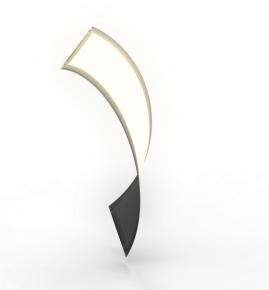
BASF's Coatings division announced that OLEDWorks uses the company's flexible barrier solutions in its Bright 3 family of OLED panels (both flexible and rigid). OLEDWorks uses BASF materials as planarization layer to enable highly reliable thin-film encapsulation.
AUO developed a transparent 13" OLED for AR applications
Taiwan's AU Optronics (AUO) developed a 13-inch 100 PPI transparent OLED display, specifically for AR applications. This is a highly-transparent display - with 68% transmittance.
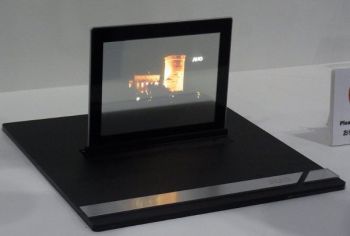
AUO 6" transparent OLED prototype (2011)
To achieve such high transparency, AUO optimized the TFT array layer stack, the OLED cathode pattern and the encapsulation. This is the first transparent OLED AUO has developed since 2011. It will discuss this new display at SID Display 2018 - and will hopefully demonstrate it as well.
OLED Ink-jet printing market situation, early 2018
Many OLED producers believe that Ink-Jet printing of OLED emissive materials is the best way to achieve lower-cost OLED TV production, and to enable OLEDs to compete in the medium part of the TV market. Ink-Jet printing is an efficient process (less material waste compared to evaporation) and it can be very quick as well. The main drawbacks of inkjet are the limited resolution and the need for soluble emissive materials which are less efficient compared to evaporation ones.
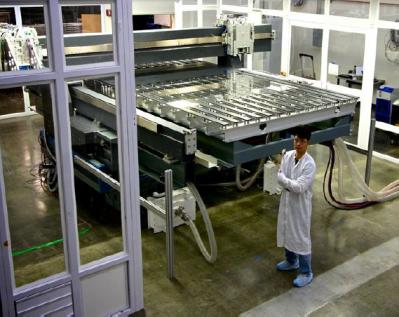
A Kateeva OLED ink-jet printing system
These challenges are being overcome, and it seems that at least four groups (in Korea, Japan and China) are charging forward towards mass production of ink-jet printed OLEDs. Ink-jet printer makers and soluble material suppliers are also optimistic ink-jet printing commercialization will soon be here as the material performance gap is diminishing.
The EU LEO project developed efficient and cost-effective OLED lighting technologies
 In 2015 the EU launched a 3-year €4 million OLED lighting project, the LEO project (Low-cost / energy Efficient OLEDs) that had an aim to develop efficient and cost-effective bendable OLED lighting technologies. The project consortium included Osram, and Cynora.
In 2015 the EU launched a 3-year €4 million OLED lighting project, the LEO project (Low-cost / energy Efficient OLEDs) that had an aim to develop efficient and cost-effective bendable OLED lighting technologies. The project consortium included Osram, and Cynora.
A month before the project officially ends, the partners updated on their progress. For this project, the partners develops several technologies, including low-cost metal foils integrating OLED anodes and possibly backside monitoring printed circuits, smart OLED top-electrode architectures and light out-coupling solutions and a novel thin film top-encapsulation strategies. These technologies together increased the light output by 50% while providing better surface scratch resistance.
Pagination
- Previous page
- Page 3
- Next page



